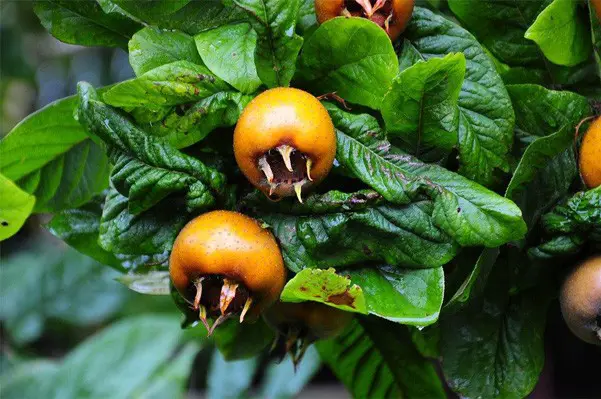Last Updated on April 3, 2024 by Real Men Sow
It’s hard to find a fruit tree that doesn’t have pink or white blossoms in spring when so many fruit trees do. Although medlar trees (Mespilus germanica) do not foam with flowers, their large white blooms against long, glossy leaves are quite striking.
These are the reasons why this striking tree isn’t widely grown:
- The golden-green fruit is tomato-sized and has to go brown and soft before consuming
- The fruit is said to have an “acquired taste”
- Often recalled as the fruit that looks like the unattractive end of a dog (cul de chien in french)
 Why You Should Grow Medlar Trees
Why You Should Grow Medlar Trees
The Medlar Tree produces delicious, sweet, and mildly citrus fruits with overtones of stewed apple. It’s more likely that they are acquiring a taste for the fruit through the idea of softening it. However, there are two types of rotting that can make a fruit unpalatable. And then there’s “bletting”, which softens a medlar’s tartness into sugars. The flesh turns into a creamy, but brown, puree. This is how you get processed fruit right from the tree.
You only need one tree because it is self-fertile. It is also free from pests and diseases. After the tree has formed its formative shape, it is only necessary to remove dead, diseased, or overcrowded branches. There’s no need to prune your trees every year.
The medlar can be a shrub on dwarfing rootstocks, or can be an ornamental tree in a garden. At Grimsthorpe Castle in Lincolnshire, UK, they’ve even topiarised theirs.
There are many cultivars, including “Royal”, which can be eaten before bletting. The most well-known and widely available variety is “Nottingham”, which has a great flavour.
Where to Grow Medlar Trees
Medlars are not particularly fussy. They like a warm, protected area with well-drained and moist soil. They will tolerate most soils as long as they aren’t too chalky or poorly drained. They should be watered in dry periods, particularly in the first three to four years of their lives.
Strong winds can cause damage to the flowers. It is best to keep them away from direct sunlight. They can tolerate some shade similar to evergreen shrubs.
Harvesting Medlar Fruit
While some people let the fruit fall to the ground, it is easier to watch them if they are picked in late October or November while they are still hard. They can be stored in one layer on dry sandpaper or paper stalk upwards, somewhere cool and light. To prevent molds and rotting, it’s a good idea for the stalks to be dipped in strong salt solutions.
The fruit will have bletted between one and three weeks later. The skin may have turned brown and become slightly wrinkled. The fruit will feel soft to the touch. It’s best to eat the fruit as soon as possible, since this is when it’s most citrusy and tangy.
How to Eat Medlar Fruit
Each medlar fruit contains chunky stones called “pips” making the edible parts of the fruitless. Medlar is a delicious combination of wine, port, or cheese. The pulp can be mixed with sugar or cream, but this reduces the flavor. It’s a delight to add it to your breakfast yogurt.
The best-known use for Medlars is to make jelly or cheese from the whole fruits. To make enough, you’ll need to make a lot. But the fun part is having your friends guess what it is.

